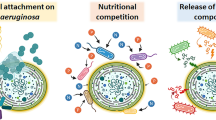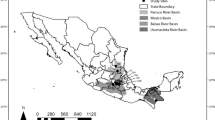Abstract
Large and harmful cyanobacterial blooms appeared in two newly-built artificial reservoirs shortly after being filled with water. Taxonomic composition of cyanobacterial communities was highly variable in both water bodies and fast species replacement was observed. In the first year of the operation of the smaller Konstantynów Reservoir, the mass development of Anabaena flos-aquae and Planktolyngbya limnetica (48.7 and 53.6% of the cyanobacterial abundance) occurred in summer, while in autumn the dominance of Planktothrix agardhii (99.9%, 14.95 × 106 ind. Dm−3) was noted. The surface scum developed in summer consisted of An. flos-aquae that contained high amounts of anatoxin-a (1412.4 μg AN-a dm−3 of scum) and smaller amounts of microcystins (10 μg eq. MC-LR dm−3 of scum). In the larger Kraśnik Reservoir, Aphanizomenon flos-aquae occurred in high abundance in spring and summer, however, it was replaced by different species of Microcystis (1.3 × 107 ind. dm−3) which created thick surface scum. Simultaneously, a hazardous increase in the total concentration of microcystins (from 13.6 to 788.5 μg eq. MC-LR dm−3 of water with scum) and anatoxin-a (from 0.03 to 43.6 μg dm−3) was observed.
Similar content being viewed by others
References
Akcaalan R., Young F.M., Metcalf J.S., Morrison L.F., Albay M., Codd G.A., 2006, Microcystin analysis in single filaments of Planktothrix spp. in laboratory cultures and environmental blooms, Wat. Res., 40: 1583–90
Bucka H., Wilk-Woźniak E., 2007, Pro- and eukaryotic algae in reservoirs of Southern Poland, Kraków, pp. 352 (in Polish)
Burchardt L., Goździcka-Józefiak A., Messyasz B., Gąbka M., Dondajewska R., et al., 2009, The influence of temperature gradient and trophic status on phytoplankton structure of Lake Góreckie (Wielkopolski National Park) during winter ice cover, In: Wielkopolski National Park in Natural Studies, Eds. Walna B., Kaczmarek L., Lorenc M., Dondajewska R., Poznań-Jeziory, pp. 11–26 (in Polish)
Burchardt L., Pawlik-Skowrońska B., 2005, Blue-green algal blooms — interspecific competition and environmental treat, Wiad. Bot., 49(1/2): 39–49 (in Polish)
Carlson R.E., 1977, A trophic state index for lakes, Limnol. Oceanogr., 22: 361–369
Carmichael W.W., 1992, Cyanobacteria secondary metabolites — the cyanotoxins, J. Appl. Bacteriol., 72: 445–459
Chen J., Xie P., Li L., Xu J., 2009, First identification of the hepatotoxic microcystins in the serum of a chronically exposed human population together with indication of hepatocellular damage, Toxicol. Sci., 108(1): 81–89
Chorus I., Bartram J., 1999, Toxic Cyanobacteria in Water: a Guide to Public Health Significance. [in] Monitoring and Management, E & FN Spon/Chapman & Hall, Londyn, pp 416
Dawson R.M., 1998, The toxicology of microcystins. Toxicon, 37: 953–962
Directive of UE 2006/7/WE, 2006.
Dokulil M.T., Teubner K., 2000, Cyanobacterial dominance in lakes, Hydrobiologia, 438; 1–12
Furey A., Crowley J., Hamilton B., Lehane M., James K.J., 2005, Strategies to avoid the mis-identyfication of anatoxin-a using mass spectrometry in the forensic investigation of acute neurotoxic poisoning, J. Chromatogr., 1082: 91–97
Golterman H.L., 1971, Methods for chemical analysis of fresh waters. Blackwell, IBP Handbook no 3, Oxford — Edinburgh, pp. 166
Grabowska M., 2005, Cyanoprocaryota blooms in the polyhumic Siemianówka dam Reservoir in 1992–2003, Oceanol. Hydrobiol. Stud., 24(1): 73–85
Grabowska M., Pawlik-Skowrońska B., 2008, Replacement of Chroococcales and Nostocales by Oscillatoriales caused a significant increase in microcystin concentrations in a dam reservoir, Oceanol. Hydrobiol. Stud., 37(4): 23–33
Hardy J., 2008, Washington State Recreational Guidance for Microcystins (Provisional) and Anatoxin-a (Interim/Provisional). Final Report, Washington State Department of Health. Washington, pp 14
James K.J., Furey A., Sherlock I.R., Stack M.A., Twohing M. et al., 1998, Sensitive determination of anatoxin-a, homoanatoxin-a and their degradation products by liquid chromatography with fluorometric detection, J. Chromatogr. A., 798: 147–157
Jöhnk K., Huisman J., Sharples J., Sommeijer B., Visser P.M., Strooms J.M., 2008, Summer heatwaves promote blooms of harmful cyanobacteria. Glob. Change Biol., 14: 495–512
Kabziński K.M., Kabziński K.A., 2006, Toxic cyanobacterial blooms. Medical effects of contact with cyanobacterial blooms, part VI, Bioskop, 1: 13–20 (in Polish)
Kardinaal W.E.A., Tonk L., Janse I., Hol. S., Slot P. et al., 2007, Competition for light between toxic and nontoxic strains of the harmful cyanobacterium Microcystis, Appl. Environ. Microbiol., 73: 2939–46
Kawecka B., Eloranta V.P., 1994, Outline of ecology of algae from aquatic and terrestrial habitats. PWN, Warszawa, pp 252 (in Polish)
Kaya K., Sano T., 1999, Total microcystin determination using erythro-2-methyl-3-(methoxy-d 3 )-4-phenylbutyric acid (MMPB-d 3 ) as the internal standard, Anal. Chim. Acta, 386: 107–112
Komárek J., Anagnostidis K., 1999, 2000, Süßwasserflora von Mitteleuropa. T1: Chroococcales, Spektrum Akademischer Verlag, GmbH, Heidelberg — Berlin, pp. 548
Komárek J., Anagnostidis K., 2005, Süßwasserflora von Mitteleuropa. T2: Oscillatoriales. Spektrum Akademischer Verlag, Elsevier GmbH, München, pp.759
Kurmayer R., Christiansen G., 2009, The genetic basis of toxin production in Cyanobacteria, Freshwater Reviews, 2: 31–50
Kurmayer R., Christiansen G., Fastner J., Börner T., 2004, Abundance and active and inactive microcystin genotypes in populations of the toxic cyanobacterium Planktothrix spp, Environ. Microbiol., 6: 831–841
Malbrouck C., Kestemont P., 2006, Effects of microcystins on fish, Environ. Toxicol. Chem., 25(1): 72–86
Mankiewicz-Boczek J., Urbaniak M., Romanowska-Duda Z., Izydorczyk K., 2006, Toxic cyanobacteria strains in lowland dam reservoir (Sulejów Res. central Poland): amplification of MCY genes for detection and identification, Pol. J. Ecol., 54: 171–180
Mazur-Marzec H., 2006, Characterization of phycotoxins produced by Cyanobacteria, Oceanol. Hydrobiol. Stud., 35: 85–109
Orr P.T., Jones G.J., Hunter R.A., Berger K., De Paoli D.A., Orr C.L.A., 2001, Ingestion of toxic Microcystis aeruginosa by dairy cattle and the implications for microcystin contamination of milk. Toxicon, 39: 1847–1854
Osswald J., Rellan S., Carvalho A.P., Gago A., Vasconcelos V., 2007, Acute effects of an anatoxin-a producing cyanobacterium on juvenile fish — Cyprinus carpio L. Toxicon, 49: 693–698
Palus J., Dziubałtowska E., Stańczyk M., Lewińska D., Mankiewicz-Boczek J. et al., 2007, Biomonitoring of cyanobacterial blooms in Polish water reservoir and the cytotoxicity and genotoxicity of selected cyanobacterial extracts, Int. J. Occup. Med. Environ. Health., 20(1): 48–65
Pawlik-Skowrońska B., Kornijów R., Pirszel J., 2010, Sedimentary imprint of cyanobacterial blooms — a new tool for insight into recent history of lakes, Pol. J. Ecol., 58(4): 663–670
Pawlik-Skowrońska B., Pirszel J., Kornijów R., 2008, Spatial and temporal variation in microcystin concentrations during perennial bloom of Planktothrix agardhii in a hypertrophic lake, Ann. Limnol.-Int. J. Lim., 44(2): 63–68
Pawlik-Skowrońska B., Skowroński T., Pirszel J., Adamczyk A., 2004, Relationship between cyanobacterial bloom and anatoxin-a and microcystin occurrence in the eutrophic dam reservoir (SE Poland), Pol. J. Ecol., 52(4): 379–390
Paerl H.W., 1988, Nuisance phytoplankton blooms in coastal, estuarine and inland waters, Limnol. Oceanogr., 33: 823–847
Paerl H.W., 1996, A comparison of cyanobacterial bloom dynamics in freshwater, estuarine and marine environments, Phycologia, 35: 25–35
PN-ISO 10260, 2002, Water quality. Measurement of biochemical parameters. Spectrophotometric determination of chlorophyll-a, PWN, Warszawa, pp. 11 (in Polish)
Polučkova A., Hašler P., Kitner M., 2004, Annual cycle of Planktothrix agardhii (Gom.) Anagn. and Kom. nature population, Internat. Rev. Hydrobiol., 89: 278–288
Rücker J., Wiedner C., Zippel P., 1997, Factors controlling the dominance of Planktothrix agardii and Limnothrix redekei in eutrophic shallow lakes, Hydrobiology, 342/343: 107–115
Scheffer M., Rinaldi S., Gragnani A., Mur L.R., Van Nes E.H., 1997, On the dominance of filamentous Cyanobacteria in shallow, turbid lakes, Ecology, 78(1): 272–282
Seip K.L., Reynolds C.S., 1995, Phytoplankton functional attributes along trophic gradient and season, Limnol. Oceanogr., 40: 589–597
Sivonen K., Niemelä S.I., Niemi R.M., Lepistö L., Luoma T.H., Räsänen L.A., 1990, Toxic Cyanobacteria (blue-green algae) in Finnish fresh coastal waters, Hydrobiologia, 190: 267–275
Smith V.H., 2003, Eutrophication of freshwater and coastal marine ecosystems: A global problem, Environ. Sci. Pollut. Res., 10: 1–14
Tonk L., Visser P.M., Christiansen G., Dittmann E., Snelder E.O.F.M., Wiedner C., Mur L.R., Huisman J., 2005, The microcystin composition of the Cyanobacterium Planktothrix agardhii changes toward a more toxic variant with increasing light intensity, Appl. Environ. Microbiol., 71: 5177–5181
Toporowska M., Pawlik-Skowrońska B., 2009, Microcystins produced by Cyanobacteria and their accumulation in ichthyofauna of a hypertrophic lake, [in:] Abstracts of the 21st Conference of Polish Hydrobiologists, Lublin, pp 165
Toporowska M., Pawlik-Skowrońska B., Krupa D., Kornijów R., 2010, Winter versus summer blooming of phytoplankton in a shallow lake: effect of hypertrophic conditions, Pol. J. Ecol. 58(1): 159–168
USEPA, 2006, Toxicological Reviews of Cyanobacterial Toxins: Anatoxin-a (External Review Draft), U.S. Environmental Protection Agency, Washington, DC, NCEA-C-1743
Utermöhl H., 1958, Zur Vervollkommung der quantitative Phytoplanktonmethodik, Mitt. Internat. Verein. Limnol., 2: 1–38
Van Apeldoorn M.E., Van Egmond H.P., Speijers G.J.A., Bakker G.J.I., 2007, Toxins of Cyanobacteria, Mol. Nutr. Food Res., 51: 7–60
Van Den Hoek C., Mann D.G., Jahns H.M. 1995, Algae. An introduction to phycology, Cambrige Univ. Press, Cambridge, pp. 623
Visser P.M., Ibelings B.W., Van Der Veer B., Koedood J., Mur L.R., 1996, Artificial mixing prevents nuisance blooms of the Cyanobacterium Microcystis in Lake Nieuwe Meer, The Netherlands, Freshwat. Biol., 36: 436–450
Welker M., Von Dohren H., 2006, Cyanobacterial peptides — nature’s own combinatorial biosynthesis, FEMS Microbiol. Rev., 30: 530–563
WHO. 2008, Guidelines for Drinking-water Quality, Third Edition, Incorporating the first and second Addenda, Volume 1, Recommendations, Geneva
Wilk-Woźniak E., 1996, Changes in the biomass and structure of phytoplankton in the Dobczyce Reservoir (soutern Poland), Acta Hydrobiol., 38: 125–131
Wilk-Woźniak E., Mazurkiewicz-Boroń G., 2003, The autumn dominance of cyanoprokaryotes in a deep meso-eutrophic submontane reservoir, Biologia, Bratislava, 58(1): 17–24
Wiśniewska M., Krupa D., Pawlik-Skowrońska B., Kornijów R., 2007, Development of toxic Planktothrix agardhii (Gom.) Anagn. et Kom. and potentially toxic algae in the hypertrophic Lake Syczyńskie (E. Poland), Oceanol. Hydrobiol. Stud., 34: 173–179
Author information
Authors and Affiliations
Corresponding author
About this article
Cite this article
Pawlik-Skowrońska, B., Toporowska, M. Blooms of toxin-producing Cyanobacteria — a real threat in small dam reservoirs at the beginning of their operation. Ocean and Hydro 40, 30–37 (2011). https://doi.org/10.2478/s13545-011-0038-z
Received:
Accepted:
Published:
Issue Date:
DOI: https://doi.org/10.2478/s13545-011-0038-z




